This post may contain affiliate links. Please read our disclosure policy.
Lebanese man’oushe is the equivalent of pizza, but slathered with a luscious za’atar and olive oil blend and traditionally eaten for breakfast.

My brother Chris was the first to speak to me of the man’oushe. Every time he returned from a trip to Lebanon I wanted to sit him down and discuss, in detail, every bite of food he’d eaten. He was happy to oblige, but nothing he described, even the elaborate meals with family and more family, made his eyes go wide like they did when he talked about the man’oushe. It’s street corner bakery food, he said. You get it wrapped in paper and off you go. They’d stopped on a whim because they were hungry and needed a snack, and it turned out to be the best Lebanese food he’d ever put in his mouth. The flatbread was chewy, but with a crisp exterior. It was blistered (ok, my word, not his) and warm, topped with za’atar or jibneh, filled with tomatoes and lifft and mint and folded over on itself.
I had to stop him. I couldn’t take it.
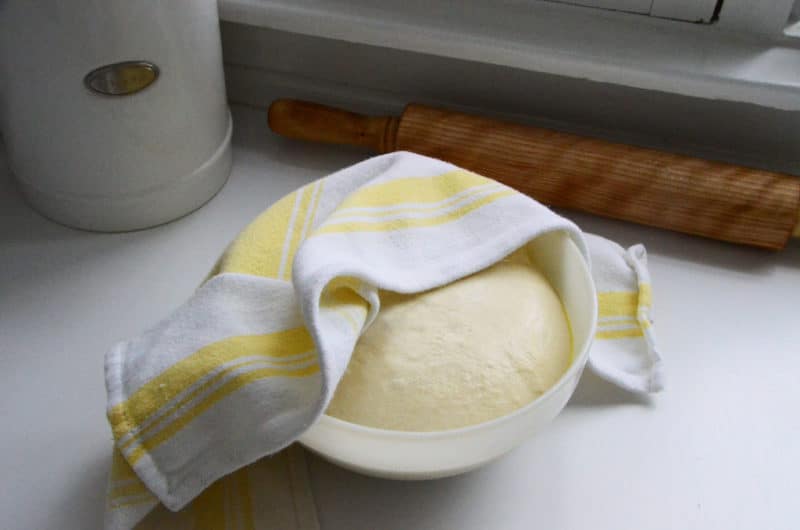
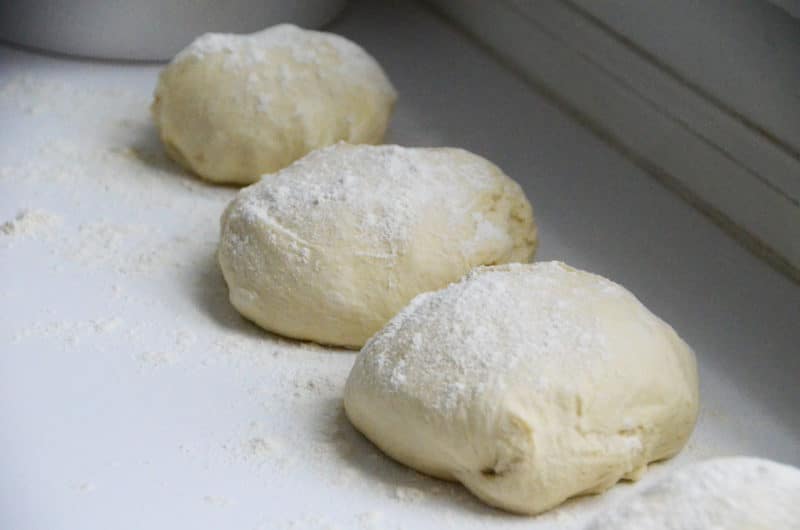
Breads like this were not unfamiliar to me; I’d had them from the Middle Eastern bakery I frequented in Chicago, and Woody’s back home sold something to this effect. But those were breads far from their ovens; those were breads that came in plastic bags.
No matter how fresh they say the bread is, it’s still bread that you get in a plastic bag. Warm-from-the-oven man’oushe with a chewy-crisp texture is something bread-dreams are made of, something you are only going to get from your own oven over here.
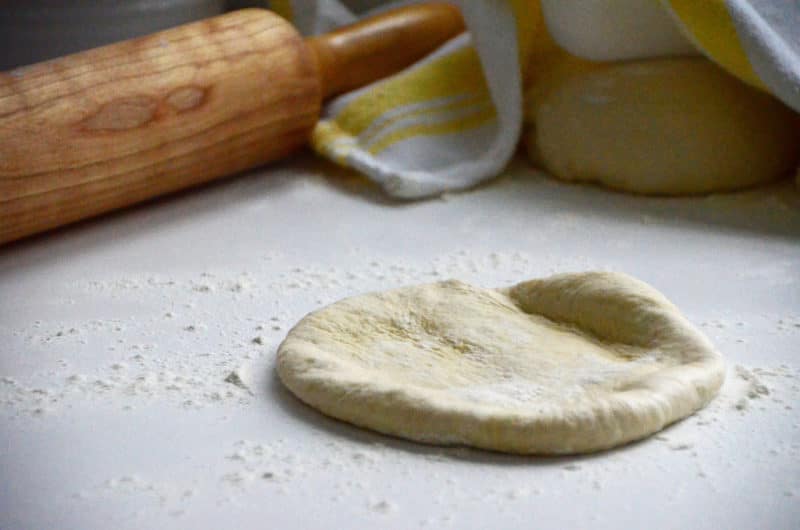
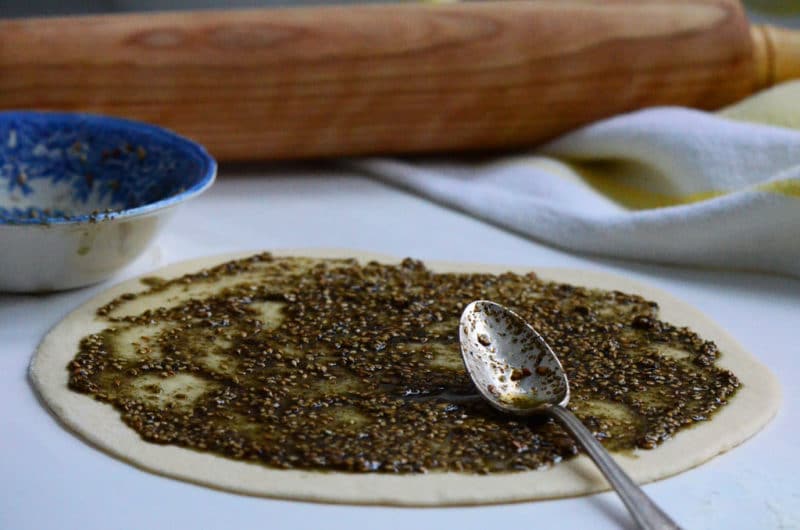
To say my list of must-eat foods on my maiden trip to Lebanon last spring was lengthy is an understatement. So when Day 2 of the trip commenced and I still hadn’t eaten my man’oushe, I began to feel anxious. We started the day with breakfast in the hotel, which was a beautiful breakfast to behold, but not a man’oushe breakfast.
It is striking to me even now that the bread, coated heavily with a mix of za’atar and olive oil, is first and foremost a breakfast food in Lebanon—just not at our hotel. Or perhaps it was on the menu and I didn’t notice it, in favor of the buffet of gorgeous fruits both fresh and dried, the labne and the pastries.
Our first stop that day was American University at Beirut, an oasis in the city surrounded by a stone wall and plenty of security. Stepping through the gates and onto the quad on that sunny morning took my breath away—for the views out over the sea, for the architecture and the massive trees everywhere, for the thoughts of my great uncle, a dean at the school who had kept a correspondence with my father long ago.
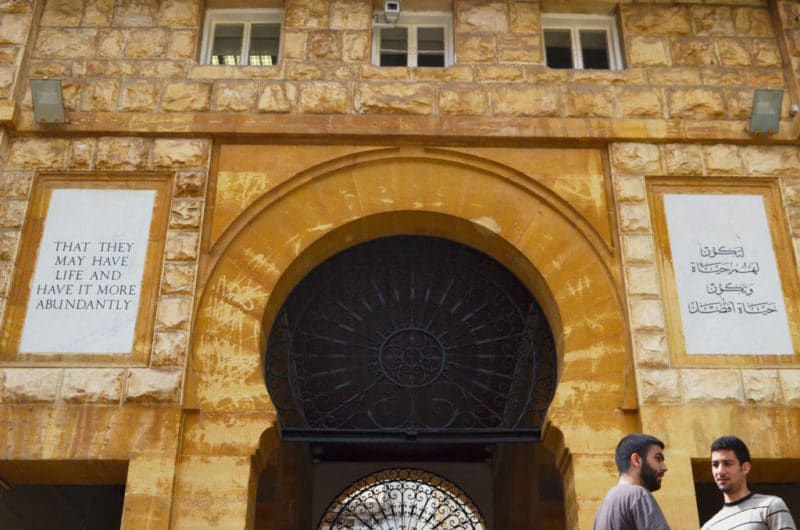
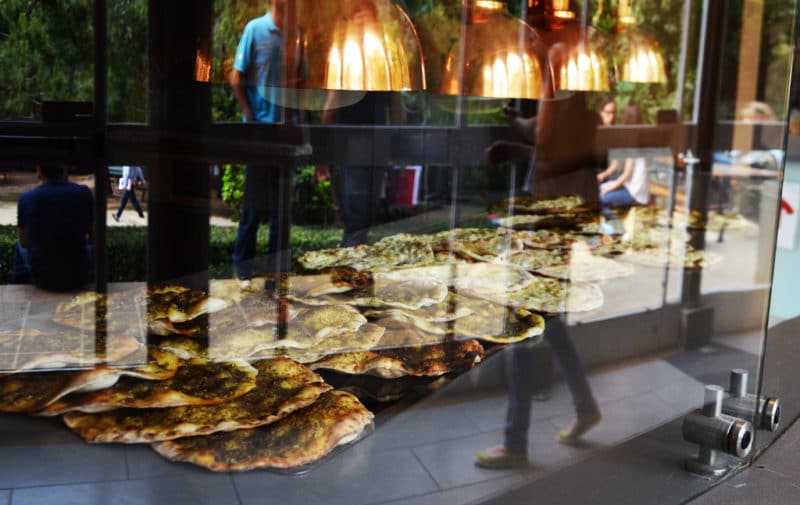
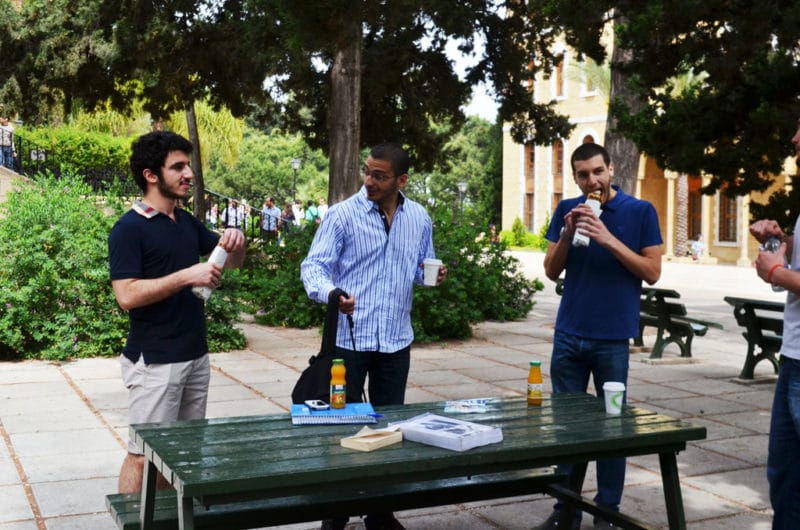
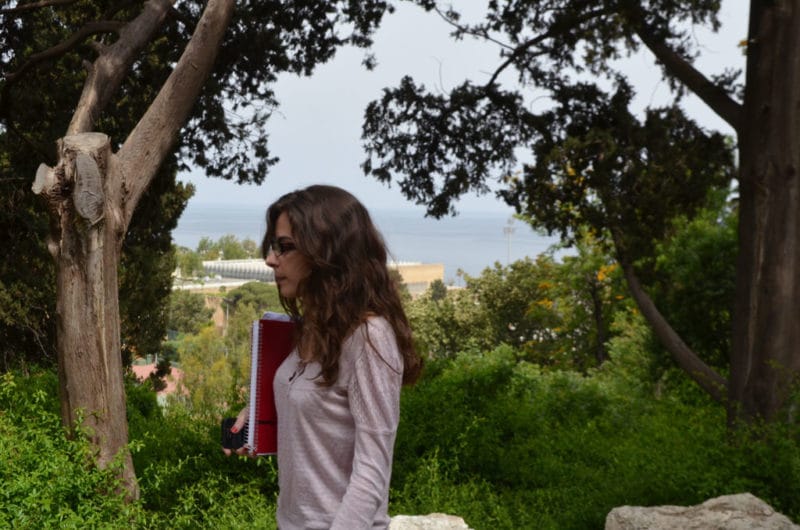
But also, and perhaps primarily, I found the students breathtaking. I have never been in a place where most everyone looks like a cousin, or a sister, or…me. And there, through the window of an unreachable student union building, I saw rows and rows of man’oushe waiting for the students to scoop them up to have with their orange juice, sustenance for a day of rigorous study and all of the fun things students do.
By the time we reached our next destination to meet our family in the village of El Mtein, I thought man’oushe would have to be tabled to a Day 3 obsession. Then cousin Chadi suggested an out-of-the-way spot for lunch, up even higher in the hills, a casual spot whose specialty is a very flat, God bless it, man’oushe.
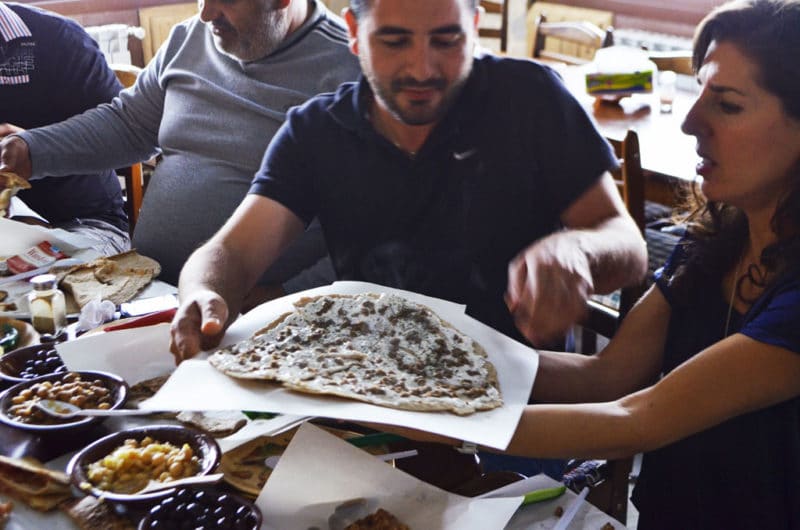
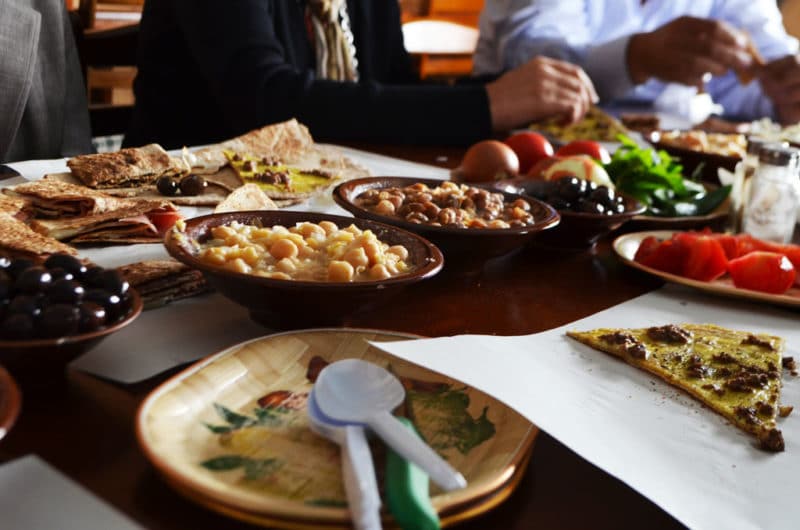
It’s his favorite, he said, his very favorite food to eat. Our bread there was topped with the classic awarma, preserved lamb confit-style; we also had labne and Jibneh on our breads, and alongside there was foul (chickpeas with beans), olives, and the requisite whole tomatoes, cucumbers and mint that are cut up and eaten with everything.
Holy Grail. Holy day. Holy moly, I vowed I would learn that bread one snowy winter’s day up north. Under the guidebook of Barbara Abdeni Massaad, a devotee who wrote and photographed an entire beautiful book about Lebanese man’oushe, I’ve been turning breads out all week long in the kind of feverish excitement that comes with reaching the summit of one’s quest. I had to call Chris downstate and tell him about the chewiness, the blistering beauty, the za’atar warm from the oven.
He had to stop me. He couldn’t take it.
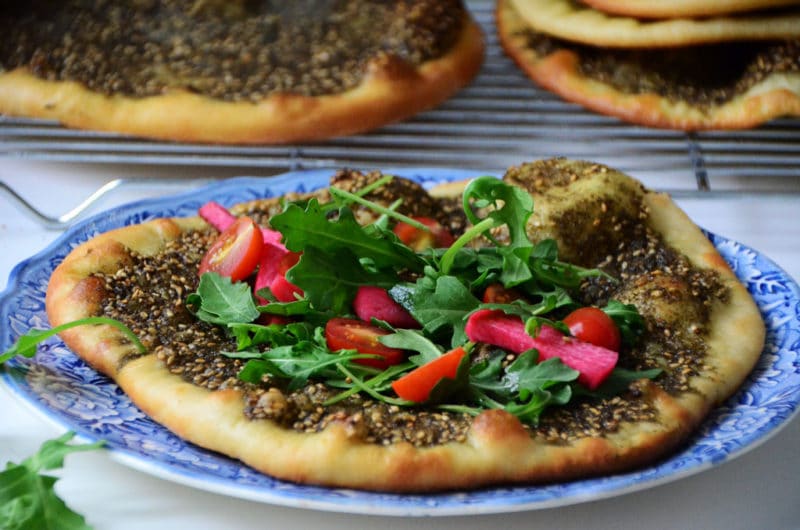
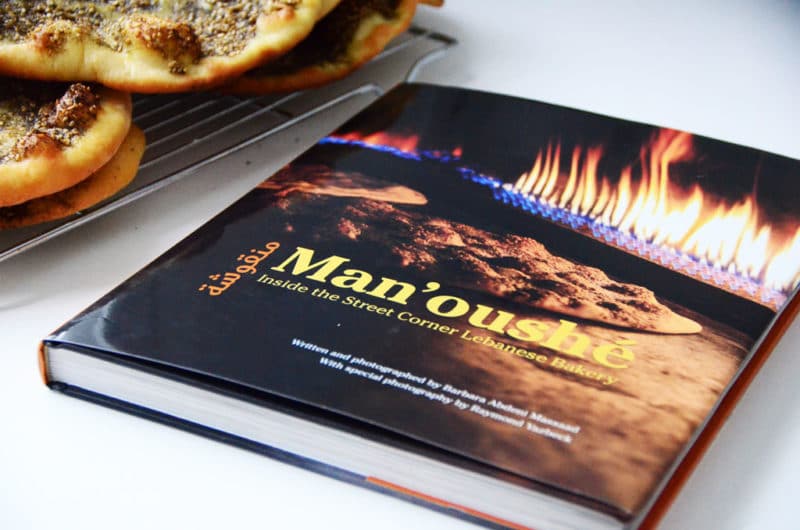
More bread baking goodness can be had baking a wonderful loaf with my Olive Bread recipe!
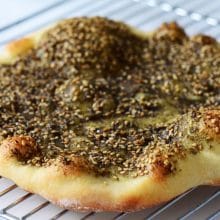
Man’oushe, Za’atar Flatbread
Ingredients
- 2 1/2 cups unbleached all-purpose flour
- 1 cup cake flour
- 2 teaspoons kosher salt
- 1 1/4 cups cups lukewarm water (90-100 degrees)
- 1 teaspoon active dry yeast
- 1 tablespoon sugar
- 1 tablespoon neutral oil, such as canola or safflower
- 1/2 cup za’atar
- 1/2 cup extra virgin olive oil
- Garnishes: tomatoes, picked turnips, mint, arugula, labneh, etc.
Instructions
- In a large bowl or the bowl of a food processor, combine the flours and salt. Whisk together if making by hand; pulse a few times if using the processor.
- Proof the yeast in a small bowl. Mix the yeast and sugar together, then slowly add ¼ cup of the lukewarm water while stirring to combine. Set aside for about 10 minutes until the yeast is foamy.
- Add the yeast mixture and the tablespoon of oil to the flour mixture. Mixing by hand, or with the food processor running, slowly pour in the remaining cup of warm water. Mix until combined and knead, if by hand, for 10 minutes until the dough is soft and elastic. If using the processor, run for a full minute after the water is added. The dough will form a ball and turn in the bowl as the machine runs.
- Set the dough to rise by placing the dough in a bowl that is completely but lightly oiled, and turn the dough so it is entirely coated with oil too. Cover the bowl with plastic wrap and then a kitchen towel and place in a warm spot (I put it in the turned-off oven that’s been just barely warmed) until doubled in size, 1½-2 hours.
- Deflate the dough by removing it from the bowl and pulling off four evenly sized balls of dough. Set the balls on a lightly floured surface and coat lightly with more flour. Cover with the plastic wrap and kitchen towel and rise for 20 minutes.
- Meanwhile, preheat the oven. Place the baking stone or overturned sheet pan (it’s overturned so the edges won’t get in the way of placing and removing the dough) in the bottom of the oven. Remove the racks or line them at the top of the oven. Heat the oven to 400 degrees for 20-30 minutes. Convection baking is ideal here, if possible. If you’re using convection, set the oven temperature to 425 degrees.
- In a small bowl, combine the za’atar and the oil, stirring well. Set aside.
- Roll out the dough: lightly flour the work surface, the rolling pin, and the peel (or another overturned sheet pan to be used as a peel like a huge spatula). The flour acts as ball bearings for the dough to keep it from sticking to surfaces. Place one ball of dough on the floured surface and press down on it with the palm of your hand. The key to getting the dough rolled flat and round is to keep it moving, which means turning it frequently throughout the rolling process and adding more flour lightly to the work surface as you go. Roll the dough from the center of the circle to the edge a couple of times, then rotate it, and roll again, repeating until the dough is round and ¼ -inch thick.
- Spread 3 teaspoons of the za’atar mixture on the dough using the back of the spoon or your fingertips to get an even, thick spread. Leave a ½ -inch rim around the edge. Slide the peel under the dough, using two hands (to avoid misshaping the round) to pull the dough onto the floured peel. Place on the baking stone in the oven and bake for 7-10 minutes.
- You’ll want to keep the oven light on to watch the bubbling baking show.
- When the bread is golden brown at the edges, remove from the oven to a baking rack and cool for a few minutes. The za’atar topping may seem oily when it’s still hot but it will dry and taste just right. Repeat the process with each of the four balls of dough.
- Eat the man’oushe as it is, torn off and eaten with the garnishes. Or top the bread with garnishes, fold over, and eat it like that.
Nutrition information is automatically calculated, so should only be used as an approximation.
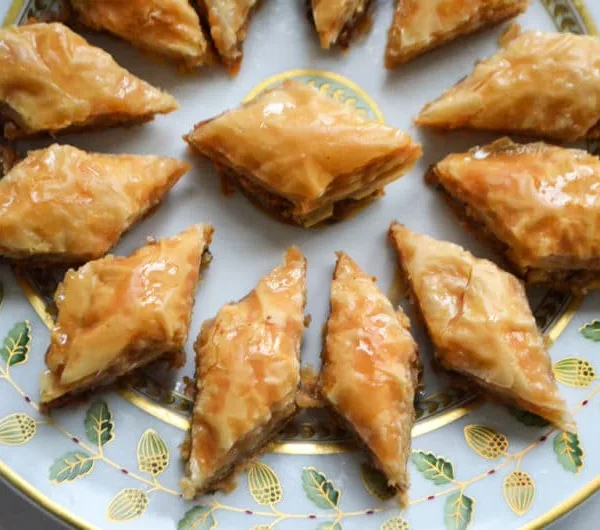

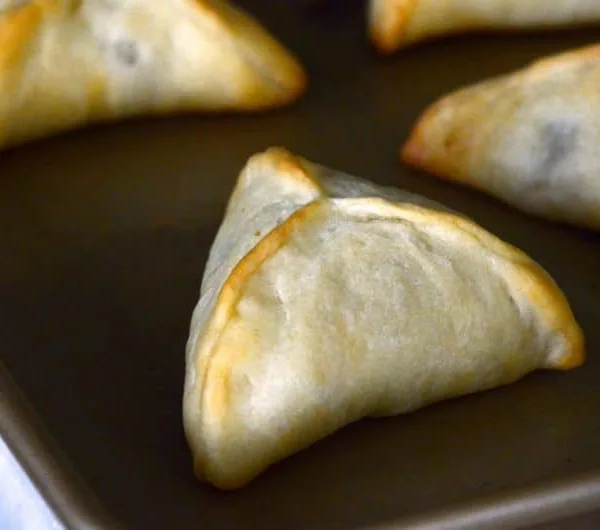
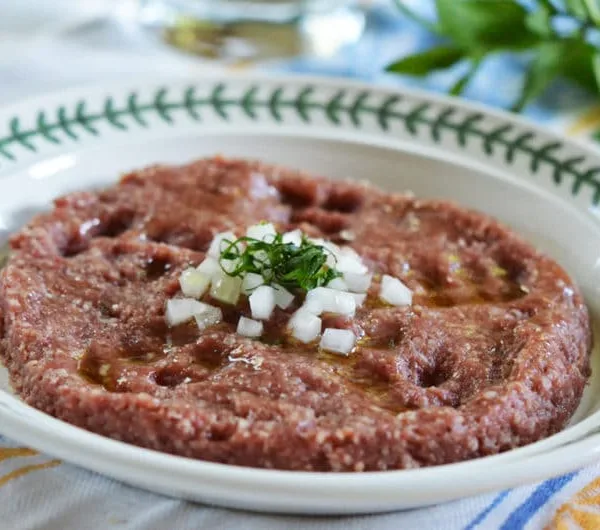







Always, always state the number of calories per standard serving! For example, a Lebanese manouche has how many calories?
Hello, we are working on getting all of the recipes with nutritional info shown, thank you for your patience!
Maureen you’re killing me…….
I grew up eating traditional Lebanese food (born in Beirut, raised in Dearborn).
I’ve since moved, and been diagnosed with Celiac… so I can’t eat normal bread. I usually substitute Cup4Cup for many recipes but this required 2 types of flour. Can you help me make this Gluten Free so I can enjoy mna’eesh again? I know it won’t be the same but, but, but, but I need this in my life.
oh the days when you get a man’oushe for 500 LL at the corner bakery are long gone.
Thank you Sally! You have to have your man’oushe! I am working on this. More to follow!
Thanks for the book. I want to make saj bread but don’t know where to get one. Do you know of a source?
Bruce thanks so much, these are available at Kitchenware shop in Dearborn, MI. I’m thrilled you want to use the saj too!
Thanks for this post and your blog. I grew up in Detroit, my grandmother was Lebanese but food in our family was completely Americanized. I learned most of what I know about our food heritage from the fantastic restaurants in Dearborn. Now I’m in the Bay Area and putting together what I can from scratch; middle eastern restaurants are very limited around here. I built a brick oven at my house for pizza, which has become legendary around my office, and then somebody at work asked me if I ever make za’atar flat bread. Embarrassed I should know about this, but I don’t. Anyway, now it’s on!
Larry, I hear you–I lived in SF and realized that what we have in Michigan is very unique. Your brick oven sounds incredible and I can’t wait to hear how your za’atar bread comes out in it!
Why cake flour? It’s a bread!
The cake flour contributes to a softer dough and softer flatbread!
1/ What can I sub for cake flour? Flours in general are hard to find due to the pandemic, but I do have unbleached flour.
2/ Will the bread get hard soon after baking, and how should I store it?
Thanks!
Ann, you can use all purpose flour for the whole batch. Store the bread in ziploc bags and reheat wrapped in foil in the oven at 300 degrees!
When the Lebanese migrated to the Caribbean in the late 19th century, they acquired a taste for the spicy food of the area. Many modified the recipes to match this. When we do man’oushie, we cut a few pieces of green Scotch Bonnet habanero chili pepper to infuse the oil. A less spicy variety that may be used is sliced jalapeno or serrano chili. It gives the za’atar a really new dimension!
I love your version of spicy man’oushe!!! I’m going to try it with our spicy Lebanese chili oil. Sounds delicious, thank you! Love the history, too.
i just got your book.simply wonderfu.
Thank you Joana!
i just got your book.simply wonderful!! easy to follow clear and well written…ty …i do however want to attempt this recipe…just wanted to be sure that one tablespoon of sugar is correct ,,seems high? thanks for any feedback or info
Thank you Mariam! Yes, the recipe is correct. The sugar plays a role in the texture of the bread. Check out my newest za’atar flatbread recipe here!
Hi Maureen, is it possible to do some of this at night so I can finish it up and bake fresh in the morning?
Hi! I haven’t split the process with overnight refrigeration with this recipe, but you can try it by wrapping the dough balls tightly in plastic wrap and chilling them overnight. They’ll still need time in the morning to come to room temp before rolling them out. I have a new recipe coming out for za’atar bread soon that includes the overnight process for easy za’atar bread in the morning. Stay tuned!
Hi Maureen, thanks for sharing this delicious recipe!
One more thing – My family was from excuse the spelling, Abdillye. Has anyone heard of this place?
I love your blog. I find it so interesting and I can just taste the food. I love to make Za’tar. Your recipe is similar to a pizza dough recipe that I use frequently with the difference being double 00 caputo pizza flour – makes all the difference in the world. Also make delicious pita right out of the oven – I toss it to my family right from the oven to the table, I’ve burned a few fingers.
When I was living at home before I married I frequently helped my mom make Syrian bread – I was the one to sit on the stool next to the oven door and flip the bread. It was so delicious. I especially loved the one that bubbled up and that was the one we ate with fresh cut summer home grown tomatoes, cucs, olives, laban or sometimes scrabbled egg – OMG it was to die for.
This Saturday July 9th we are celebrating my sister’s 75 birthday. I will be making all her favorites i.e. Kibbi, Za’tar, Syrian salad, hummus, baba, labne, grape leaves – fresh picked, stuffed koosa, eggplant with meat and pine nuts and of course rice. I can’t wait till Saturday. I love your website – your blogs etc.
My fathers favorite was Zatar on Syrian bread with a mashed banana. The savory mix of sweet and sour is a delicious combo. i enjoy your posts so much as well as all the familiar recipes. Going home now to make baba ganoush, and humus for my “American” friends. Have a good weekend
Wow, that sounds so good and so unique. I will try it! Thanks Michele!
Thanks for this – I made the dough through the first rise, then it turned out that I had to go out and couldn’t make the bread that evening. I oiled it, then stuck it into a plastic zipper bag in the fridge. Pulled it out a few days later, let it have the second rise, and made the breads. I added a little extra sesame seeds and sumac to my zaatar mix. Wonderful!
I’m so glad to hear that the refrigeration of the worked great! That no doubt gave it more flavor, too!
Ira’s comment made me laugh since I’m Lebanese from western NY. Last fall, I bought corn whiskey from a new distillery in Olean, NY. The town has several Lebanese families plus a hill (locals says it’s a mountain) called Mount Herman or Hermon!
An acquired taste? I fell in love with za’atar bread after taking my first bite 40 years ago in Jerusalem. This weekend some friends and I will be making some using Maureen’s recipe. We will also be driving into the hills of Lebanon (New York State, USA) in order to buy some home-made corn whiskey, which I think is more of an acquired taste.
Drinking corn whiskey and eating za’atar bread both from Lebanon (although two different places), strikes me as a lovely way to spend a Saturday afternoon with some friends and my sister-in-law.
LOVE this!
For Christmas I purchased Maureen Abood’s book, olive oil, and many others items for my 92 year old Druze Lebanese mother. I must tell you that the smiles on this women’s face while she turned the pages on this great cookbook was magical !!!
Thank you Maureen for all that you do !
Love to all
Larry
I’m so touched! Thank you so very much Larry, and my warm regards to your beautiful mother!
I bought a copy of your cookbook after coming across this blog last week. I’m really intent of making the delicious Lebanese dishes I grew up eating. I always found it amazing that my mom cooked all of our meals from scratch without a written recipe, and her cooking was and continues to be incredible. Most of what I grew up eating is in your cookbook. I didn’t truly appreciate it until I moved away and it was no longer easily accessible.
I have a question about this recipe….specifically around the use of a food processor for making the dough. I’m curious why you prefer the food processor over a stand mixer, which seems like the universal appliance for dough making?
Hi Kristina–thanks so much! I really enjoy how the processor works the dough to a great balance of strength and softness (softer than the stand mixer), to achieve the flat, bubbly flatbread. The stand mixer will of course work for you though!
I love Lebanese flatbread, your recipe sounds great, how can I make it gluten free and yeast free, I am also a vegan. I have tried several gluten free recipes and they just are not even close, most taste awful. Help please.
Hi Linda–I have not developed a gluten-free, yeast-free, vegan recipe for this bread, I’m sorry! I imagine that it’s quite challenging to achieve the bread’s many qualities without those ingredients!
I know I am late to this party but, Thanks for this one Maureen!
You’ve made me long for Mama’s Lebanese Bakery in San Diego. You must try it if you’re ever there. Eating Mana’oushe sandwiches on their patio on an 80 degree March day is divine.
I’ve made this recipe about four or five times now, and I have to thank you. It’s incredible! Thank you so much for sharing, and with such vibrant commentary and beautiful pictures. 🙂 I am just about to pull a loaf out of the oven and I am so excited to have it for dinner with some veg.
My mother probably made millions of loaves in her lifetime. She used the same dough for Syrian bread, fatayer, za’tar, everything. Hers were deliciously chewy and we always ate them with zatun. Heaven. As far as I know, she never used cake flour – I wish I had her dough recipe, because mine just doesn’t have the same texture as hers did. I guess I’ll have to try the cake flour and maybe that will bring me closer to replicating her wonderful dough. She had a huge cast iron sheet on the bottom of her oven to bake the breads on, and large wooden paddles for sliding them into and out of the oven.
I wonder if you or your readers know about this topping she made about as much as she made za’tar:
Red bell peppers, walnuts, sesame seeds, olive oil and hot pepper flakes – she would put the red peppers and walnuts through her meat grinder, and then mix with oil oil and sesame seeds and hot pepper, and spread on the dough and bake. I love za’tar, but this was my favorite. I have searched and all I can find is Lebanese Muhammara recipes (like yours). It wasn’t really smooth like the dip can be, but the recipes seems similar. I wonder if it’s something she made up?
Love your comment about all the doppelgangers in Lebanon. 🙂
This Sunday in Saigon felt just like the old days back home. My very own home made Mankoushe…
Thank you for posting and sharing…
https://hr-michelle.tumblr.com/post/96841045430/finally-breakfast-home-lebanon-manoukshe-at
Hi
Thanks for recipe.
I was at Dearborn, MI last weekend. It was great experience.
I am Turkish I cook everyday Turkish
This was what I eat there I am going try your recipe inshiallah
Thank you again
Have a great day
Thanks for the recipe…yours looked like the best I’ve found online. I had these at a market in Paris and have been longing to try making them at home.I was just wondering about the quantity of sugar which is much more than elsewhere….is it definitely a tablespoon rather than a teaspoon?
Hello! I use a tablespoon, but you can reduce to a teaspoon if you prefer, and the recipe will work just fine!
It is possible to bake it also in a pan without oil? Or it has to be baken in the oven? I mean, makes it maybe a different?
Thank you, Kind regards.
You could try this in a large cast-iron skillet but my sense is that the overall heat of the oven is necessary to bake this bread!
Omg, found what I was looking for. I’m somali love Lebanese food especially zatar bread..
I found your recipe the best and easy to flow and Ive already made zatar bread and it turn out perfect .love it
Thank you Maureen Abood.
That is so great Faiza, thank you!
Hi Maureen,
I wish I could meet you in person and spend a day in your kitchen. My husband is of Lebanese decent and his father moved here from Beruit in the 70’s. I met my husband at college and we now reside in Sheboygan but I am originally from MI as well. As I write this, my dough for the man ouse is rising in the oven and i can’t wait to try it. I learned to love Middle Eastern foods before I met my husband but now I want him to experience the foods of his culture even more, so I’m trying all the recipes I can. Thankyou for this wonderful website and I hope my flatbed is a success! God bless you!
Rebecca, how great! Thanks so much, and I know your flatbread will be delicious–it’s made with that most excellent ingredient: love!!
Hi Maureen, I wrote to you recently about your amazing kneffi recipe… but I have another question about Manaeesh. I noticed you had lived in San Francisco at one point, which is where my daughter and I live now. Can you recommend any places here where we can get really good manaeesh? In Lebanon (Haret Saida), my uncle-in-law owns a local bakery and we got fresh manaeesh, and many other things from him, right around the corner from my in-laws apartment. So, yeah, we got spoiled. Always preferred the cheese to the zataar, but I also enjoyed the combo of the 2! Yes, there was a cheese/zataar combo… sigh… anyway, if you have any recommendations for places here in SF, I would be eternally grateful. Thanks again for your heartfelt recipes, which are so much more than recipes. You are the whole enchilada, pictures, memories, recipes, philosophies… it’s very enlightening and also motivates me to eat/cook/find… Thank you! -Sarah
Hi Sarah–lucky you, in SF! It’s a wonderful place, but not one that offers much in the way of Lebanese or Middle Eastern cuisine. I think you will find something special, though, at the new Bouli Bar at Boulette’s Larder in the Ferry Building–they make a za’atar “pizza” and have real Middle Eastern flair. I worked at Boulette’s for a couple of months after culinary school making flatbreads; the Bouli Bar with the hearth is new since I left. Thank you for your very kind words, Sarah. Means a lot.
Pictures – wow! Such great pictures. Can you provide your settings? Maybe just for the last two? They are the best. Thanks!
There is a store in Fishers, Indiana called Al Basha that bakes za’tar bread and it is very good! I buy it almost every time I go there. I love it!
How great you’ve got a bakery that makes za’atar bread! Lucky you…
Hello, I live in Torrreon,Coahuila, Mexico,
We alwyas eat Za´tar with bread and olive oil, so when I saw the differents ways we can use the
za´tar, please tell me how I can get your recipe book
Thanks in advance and
Best Regards
Margarita Juan Marcos Issa
maguej50@hotmail.com
Hi Maureen, Are you able to offer a gluten free man’oushe recipe? Thank you.
Lisa, you’re not the first to ask! I will work on it, thank you!
Thanks, very simple and easy to prepare recipe. And the same time delicious. Thanks
WULLAH!!
Ain’t nothing like zatar bread!!
Hello Maureen,
Your description and childlike excitement for man’oushe brought me back to my youth, when my parents and grand parents who were from Lebanon, the village of Gharzouz, made bread on weekends. It also returned me to my wonderful visit to Beiruit and Gharzouz to meet my mother’s relatives. I had the very same reaction you did upon seeing everyone….they LOOK like ME!! I felt so at home as soon as I walked ashore and regret not being able to stay longer – I was a young naval officer making a port visit. I’m very fortunate to be able to have a Lebanese bakery, two in fact, within 20 minutes of my home. Interestingly, they call the man’oushe man’eesh. However one may pronounce it, it’s a bite of home and heritage. I had one fresh from the oven this morning. Thank you for your posting. I hope to read more of your posts.
Thank you Bill for that lovely comment, and what a great story about your visit to Lebanon as a young man!
I found your website while reading the comments after a story on za’atar on NPR. I would love to expand my baking repertoire by trying to make some manoushe myself. I need some za’atar though. My only local option is one made by Ziyad. Is that any good or should I wait until I can go shopping at a Middle Eastern grocery in Chicago? Thanks for the recipe!
I think the Ziyad is acceptable (green za’atar)–go for it!!
Thanks for the encouragement. I will try baking the manoushe this weekend!
Stopped dead in my tracks when you mentioned Woody’s, are you from East Lansing? Loved, loved Woody’s! Miss my Lebanese friends in Michigan, but think about them when ever I cook from my battered and stained cookbook from St. Joseph”s Melkite church titled “The Art of Lebanese Cooking”. Discovered your blog today via Saveur and am so glad I did!
Tammi, those old church cookbooks are great! And yes, I’m from Lansing…. Thank you for you words, & I look forward to seeing you here!
Yummy that is a very delicous man2eesh …
I came here via the post on the kitchn on za’atar where I was drooling over that bread–how excited was I to see the recipe here!? Can’t wait to make it.
Sara, thank you and welcome. Three Clever Sisters–how…clever! Let me know how you like the man’oushe (it’s SO good)!
Just had some for lunch. Really easy dough to work with and roll out, and of course I love the za’atar. You’re right about it looking so oily right out of the oven and then cooling fine. I actually ran the oven at 475 convection as it was cooking too slow and it worked nicely. Also I made some with smashed chickpeas (since I don’t have enough za’atar)–read in Claudia Roden that it’s a Lebanese Lenten tradition.
Let me clarify, the warm fuzzy part for the grands……not sad, lol.
I’m planning on making Syrian bread and kaak this coming week and now after reading this I’ve got to add za’atar to that. This may be a straight 24hr project….put on the coffee. Can’t wait to get started.
Thanks for all your wonderful words, you bring back memories and your readers share so many things that parallel my life as well. I always feel warm and fuzzy after reading your posts and slightly sad for those long ago days. I hope I can create the same feeling for my grandchildren. ♨
Looks wonderful. I have never had turnip on it. I will have to try. Whenever I make dough to make man’ooshe my kids always want me to make it with sweet sumsum (sesame seeds) instead of za’atar .
Simply a wonderful article, with beautiful pictures. Thank you Maureen.
Wow, lots of activity today.
My senior relatives only put the Za-atar on what they called a talame, which was the same dough they used for the large thin bread but made about a half inch thick with the Za-atar on top. This looks thinner and I can see where the chewy crisp texture would come from. Our talames came with and without Za-atar and were thick enough to use like pocket bread but had to be slit open with a knife. Great article and lots of good photos. Will forward this info on to my brother who still experiments with making his own bread with an old gas stove that came from my grandmother’s home.
Funnny that you say they look like you and so on. Years ago I met a distant cousin in Washington DC, they were over here from Beirut on a grant to study our tax system. My uncle had warned (and ordered) me to treat him like “family”. I wondered how I would recognize him. When I walked into the hotel where he was staying and saw this fellow sitting on a couch in the lobby….THERE WAS NO DOUBT! 🙂
Thanks for the article.
I love just about all kinds of flatbread. I am so excited to see that you posted this recipe. I’m very intrigued that it uses cake flour. I will definitely give it a try soon (I’ve been craving flatbread for a few weeks now).
Janel, the cake flour and the intensive mixing in the food processor work together to help control the “breadiness” of the crumb and give the bread it’s irresistible chew. Very clever method!
Wonderful post, Maureen. What is za’atar, and can I get it at Al Khyam on Kedzie, do you think? –Cathy
Thank you Cathy–za’atar is a spice mix of roasted thyme, sumac and sesame seeds (read more here) that you can get at Al-Khyam!
Maureen, everytime I get an email from your site it makes my mouth water for some of the delicuous home middle eastern cooking that I grew up on…..now I’ll have to go to the local Middle Eastern supply store and get needed items to make some of the dishes noted in your website……..keep up the good cooking…………….Thanks for such a mouth watering back home cooking site…………..
Ronnie….in Southeast Texas…….
Hi Maureen, you made me laugh when you wrote about the students at the AUB looking like your relatives or you! I really enjoyed this post because I could definitely relate to the man’ooshe passion. I had it for years while living outside Lebanon but now that I am in Lebanon my passion for man’ooshe has been replaced by a passion for kaak; more on that later. Did you have a chance to taste Abu Arab’s kaak or the kaak in Basta while you were here?
Joumana, I’m working on kaak right now! Wonderful. I had great kaak in homes in Lebanon but didn’t have either of the ones you mentioned.
where will i find man’oushe in los angeles? please . . .
Wonderful article & beautiful pictures…as always!! Now I’m hungry!!!
Lovely bread!
Maureen, just had to have za’atar bread this morning–used sliced sourdough bread in place of homemade Syrian bread–has some of the same properties–is chewy–but still NOT the same–but it worked
Wow Maureen! Awesome entry and recipe! Look forward to making this!
What a wonderful post! You awakened a desire to go immediately to Beirut and eat . . . continuously. Thanks for sharing both this story and the beautiful accompanying photographs.
Help me here. The bottom of my oven is where the heating coils are. Do I set the stone directly on them or should I set a rack as low as possible and put the stone on that? How do these reheat? They are beautiful! Thanks! ga
Thanks Gretchen, good questions. You’ll set the stone on the rack, but you may have to put it up a little from the coils or else it could get too hot and burn your bread. Try a slightly lower temp with the oven, given that the heat source will be directly below your stone (375). The breads reheat beautifully at 350 or under the broiler, as I did today for breakfast…
I am making this recipe for the first time. If I don’t want to bake it all at once, can unused dough be stored in the refrigerator? Thanks!
Hi Deborah, you can refrigerate unused dough for a day or so–check this recipe for more info too.
You are so cute! You tell and great story and I just loved “holy moly”. And sounds soooo delicious! On my list now — what is the bakery in Chicago since that is closer than Lebanon for me? Much love, J
Thanks Jo Ann! Al Khyam bakery is up north on Kedzie, a wonderland of Middle East groceries, baked goods, and dishes.
Love love love za’atar bread! And yes, for breakfast!
Beautiful, so beautiful (said in Beiruti accent!)!! I need to buy this lady’s book, sounds awesome. Well done, Maureen!
Thanks for sharing the recipe. Have been looking for it. Great pictures. They capture well the story.